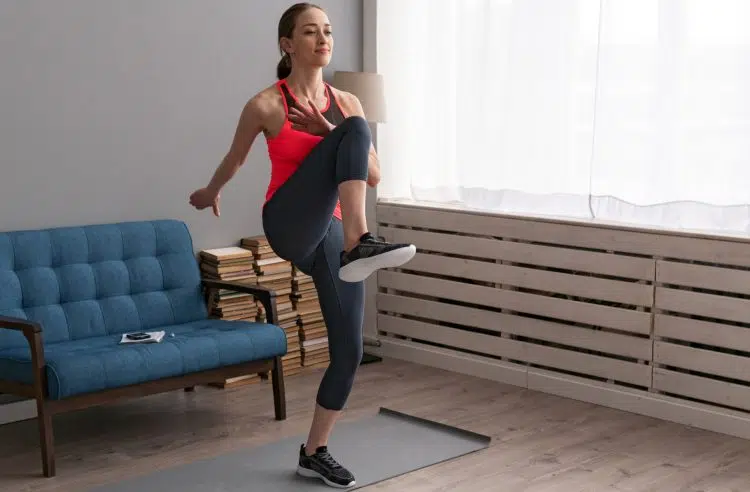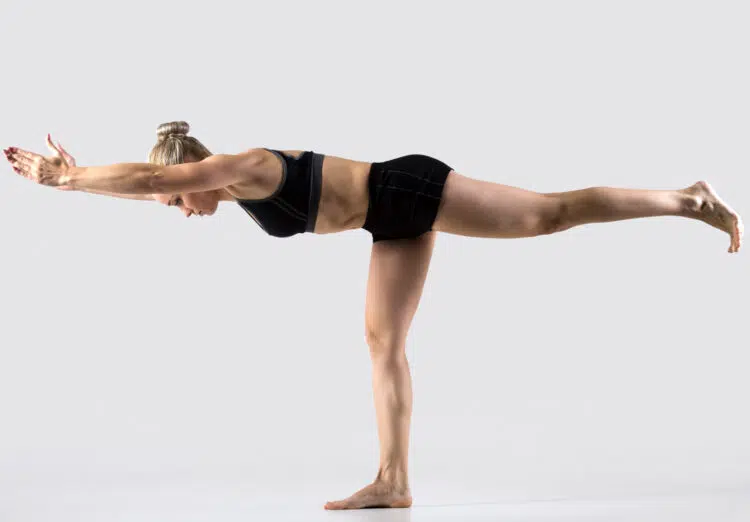Contrary to what most people think, physical activity isn’t just for physical fitness; it can have a significant impact on your mental health as well.
The number of people battling issues like anxiety, depression, and stress is rising every day. Unsurprisingly, a lack of physical activity is one of the most common traits these people share. Research shows that exercise, especially when performed outdoors, can improve mental health outcomes in adults, including those with pre-existing mental health problems. (1)
Mental resilience is more critical than ever, as it offers the inner strength required to handle setbacks, navigate challenges, and thrive under pressure.
The good news is that physical exercise and activity can help improve mental health. Have you ever noticed how an intense workout makes you feel good? That’s what we are aiming for here.
In this article, I take you over three types of workouts (HIIT, endurance, and balance) that can be used as powerful tools for building mental resilience. I’ll also share how to implement them in your workout and ensure consistent progress. We have a lot to unpack, so sit tight and read on.
High-Intensity Interval Training (HIIT) for Stress Relief

High-intensity interval training (HIIT) is one of the best methodologies you can adopt to transform your physical and mental health.
Level Up Your Fitness: Join our 💪 strong community in Fitness Volt Newsletter. Get daily inspiration, expert-backed workouts, nutrition tips, the latest in strength sports, and the support you need to reach your goals. Subscribe for free!
One of the best things about HIIT workouts is that you don’t need to spend over an hour in the gym to get the best bang for your buck. Most HIIT workouts last between five to 30 minutes, making them suitable for people with jam-packed schedules.
HIIT Workout To Relieve Stress & Improve Muscle Conditioning
Here is a sample HIIT workout you can try:
| Exercise | Work | Rest |
| Jump Squats | 30 seconds | 15 seconds |
| Push-ups | 30 seconds | 15 seconds |
| Mountain Climbers | 30 seconds | 15 seconds |
| Plank | 30 seconds | 15 seconds |
| Crunches | 30 seconds | 15 seconds |
| High Knees | 30 seconds | 15 seconds |
| Lunges (alternating) | 30 seconds | 15 seconds |
| Burpees | 30 seconds | 15 seconds |
Perform each exercise for 30 seconds and rest for 15 seconds. Complete two rounds of each exercise before moving on to the next movement. Prioritize using the correct form instead of trying to do as many reps as possible within the stipulated time.
Although most of these movements are suitable for beginners, feel free to switch any exercise based on your current fitness level. For instance, you can switch jump squats with air squats.
Finally, warm up before starting this workout to avoid the risk of joint or muscle strains. Dynamic exercises like arm circles and leg swings are excellent for boosting blood flow and warming up the target muscles.
Besides helping you torch calories, HIIT workouts trigger the release of endorphins, which can help calm your nerves and make you feel more focused. (2)
Endurance Exercises for Grit and Determination
Endurance training is one of the best ways to maximize your physical capabilities. This training modality can help you perform at full capacity for longer periods.
Low-intensity steady state (LISS) training is the most optimal for building your performance threshold levels. LISS training includes monostructural exercises like running, swimming, and biking. These exercises involve repeating the same action repeatedly in a rhythm.
Besides building your physical endurance and stamina, LISS training helps forge mental toughness. Running a marathon (42 kilometers) will help develop an iron will that will bleed into every other aspect of your life.
Training for long, brutal events will teach you to embrace discomfort and smile in the face of adversity.
When all is said and done, the sense of accomplishment that surrounds you after you’ve completed one of these grueling events makes you feel indestructible.
Not only that, the greatest thinkers ever have had their best ideas during low-intensity exercise sessions like walking, swimming, or jogging. This is no coincidence. Endurance training can make your mind quiet down and mute the background noise. I would go as far as to say this is the closest most people come to deep meditation.
LISS training puts your brain into a rhythm and a flow. Many people take voice notes during LISS workouts to record their thoughts and ideas. I highly recommend you give this a shot.
Endurance Workouts To Build Grit and Determination
I wish I could give you an endurance-building workout. However, these vary greatly depending on your current fitness level and objectives.
For instance, training for a 5K will vary greatly for a beginner and someone who has run multiple half marathons. I highly recommend working with a coach and following a personalized training protocol. It speeds up your progress and limits the possibility of injury.
Here are a few factors that you must consider before beginning your endurance training journey:
- Start small and build gradually: If you are a beginner and your ultimate goal is to swim 2.4 miles, you should begin by doing multiple 50m laps. Increase the distance and training frequency as you gain more experience.
- Find your pace: Endurance sports involve maintaining a constant pace for an extended period. Learn about the average pace for your sport and train to match that number.
- Prioritize proper form: Irrespective of the sport you pick, you must first focus on learning the correct training technique. This approach helps maximize efficiency and results while preventing injuries.
- Set realistic goals: Many people make the mistake of setting too ambitious goals, which is why most people quit before attaining them. Although they might be motivating initially, they can make you feel exhausted.
Balance Workouts for Focus and Concentration
To be honest, I’m the most clumsy individual I know, which makes most high-skill exercises like gymnastics and Olympic weightlifting feel very awkward.
Poor balance also signifies a lack of focus and concentration, which hampers your training and day-to-day performance.
Level Up Your Fitness: Join our 💪 strong community in Fitness Volt Newsletter. Get daily inspiration, expert-backed workouts, nutrition tips, the latest in strength sports, and the support you need to reach your goals. Subscribe for free!
Over the past few months, I’ve been experimenting with balance workouts, and I’ve seen incredible results. They’ve also helped improve my mind-muscle connection and hand-eye coordination.
Balance training enhances your proprioception, which is your body’s awareness of its position in space. When your balance is challenged, your brain has to fire up to coordinate movement and realign its focus. This makes balance training a potent cognitive function exercise.
How To Employ Balance Training
Depending on your age, training experience, and goals, you can adopt several balance training methods, including single-leg stances, yoga poses, and stability ball work. Here are a few exercises for people of varying experience levels:
Beginner
- Single-leg stance: This involves standing on one leg for 30 seconds. Close your eyes to make it more challenging.
- Heel-toe walk: Imagine walking a tightrope. Add to the difficulty by holding your hands in front of your chest and closing your eyes.
Intermediate
- Yoga poses: Warrior III (Virabhadrasana III), Half Moon Pose (Ardha Chandrasana), and Tree Pose (Vrksasana) are excellent for building strength and stability.
- Lunge with a twist: Twisting your torso to each side can help take your balance game to the next level.
Advanced
- Stability ball exercises: Try planks and push-ups on the stability ball. Ensure all safety parameters are in place.
- Single-leg deadlifts: These require a decent amount of balance, focus, and coordination and will help strengthen your core.
Cultivating Discipline and Mental Fortitude
Whether you’re training for strength and muscle gains or mental conditioning, you cannot overlook the importance of discipline and mental fortitude in achieving your goals. Discipline will get you out of bed at 5 a.m. to practice the balance drills or push you through the final reps of a HIIT workout when every inch of your existence hurts.
Here is how you can cultivate mental fortitude and conditioning:
Setting Rock-Solid Goals
The American Council on Exercise suggests setting SMART goals. These goals should be specific, measurable, attainable, relevant, and time-bound. They ensure accountability and can help fuel your motivation.
“Lose weight” is a vague goal. Instead, set yourself an objective that looks something like this — lose 10 pounds of fat in three months by following a structured workout plan and nutrition guidelines.
More importantly, you must learn to cope with setbacks. Yes, you will have many. Setbacks aren’t failures; they are a source of feedback. They are opportunities to learn, adapt, and grow.
Sticking to the Plan (Even When You Don’t Feel Like It)
An inability to stick to a schedule is one of the biggest reasons most people fail to meet their fitness goals. This is where discipline comes in and will help make exercise an indispensable part of your routine.
Begin by setting aside a particular time in the day for exercise. No matter what happens, you must honor this commitment. Find a workout community in your city or online, as they can offer valuable encouragement and accountability. Finally, you must celebrate your wins, no matter how small. This will give you a mental boost to go after the bigger goals.
Progressive Overload
Whether you are training for muscle or strength gains or boosting mental fortitude, gradual exposure to challenges is one of the most important growth factors.
Begin with small and manageable stressors and gradually increase the intensity as you gain more experience. Staying in the same place for an extended period can lead to plateaus, which can be extremely hard to break through.
Read more: Progressive Overload: The Science Behind Maximizing Muscle Growth
Breaking Through Mental Barriers
It is impossible to eliminate self-doubts. Anyone who says otherwise is lying.
However, you must conquer all the doubts and excuses to march toward your objectives. This will take daily effort, but you must stick to it.
Many of my clients report overcoming mental barriers via mindfulness techniques like meditation, yoga, and journaling. These methods take out all the stops and allow you to unleash your true potential.
You must also learn to embrace the discomfort. Whenever you are trying something new, it will feel weird and uncomfortable. But remember, this is where the magic lies.
I highly recommend adopting visualization techniques. Manifestation isn’t a myth. Close your eyes daily and imagine yourself crossing the marathon finishing line, and the world will conform to make that happen.
Learn To Listen To Your Body (And Mind)
HIIT and endurance training can weigh heavily on your body and mind. Feel free to take a day off training if you feel overly sore or exhausted. This is your body telling you that you need more time to recover. Consult your healthcare provider if you notice any aches or pains.
Remember, building mental resilience isn’t a sprint. It is a long-term process that will help you maximize your full potential. Stay consistent, disciplined, and focused, and you’ll get to your goals.
Conclusion
To function at your maximum capacity, you must stop treating your mind and body as separate entities. Remember, your mental well-being can impact your physical health and vice-versa.
Depending on your current fitness level and most immediate goal, pick one of the training protocols listed in this article and stick with it for at least eight weeks. The results you experience will be nothing short of magical.
While going through these programs, you must remember that a growth mindset is one of the most important factors. It encourages you to embrace challenges, learn from your mistakes, and push you to seek mastery. Best of luck!
If you have any questions about the workouts or training techniques explained in this article or need help implementing them into your routine, post them in the comments below, and I’ll be happy to assist.
References:
- Coventry PA, Brown JE, Pervin J, Brabyn S, Pateman R, Breedvelt J, Gilbody S, Stancliffe R, McEachan R, White PL. Nature-based outdoor activities for mental and physical health: Systematic review and meta-analysis. SSM Popul Health. 2021 Oct 1;16:100934. doi: 10.1016/j.ssmph.2021.100934. PMID: 34646931; PMCID: PMC8498096.
- Saanijoki T, Tuominen L, Tuulari JJ, Nummenmaa L, Arponen E, Kalliokoski K, Hirvonen J. Opioid Release after High-Intensity Interval Training in Healthy Human Subjects. Neuropsychopharmacology. 2018 Jan;43(2):246-254. doi: 10.1038/npp.2017.148. Epub 2017 Jul 19. PMID: 28722022; PMCID: PMC5729560.











